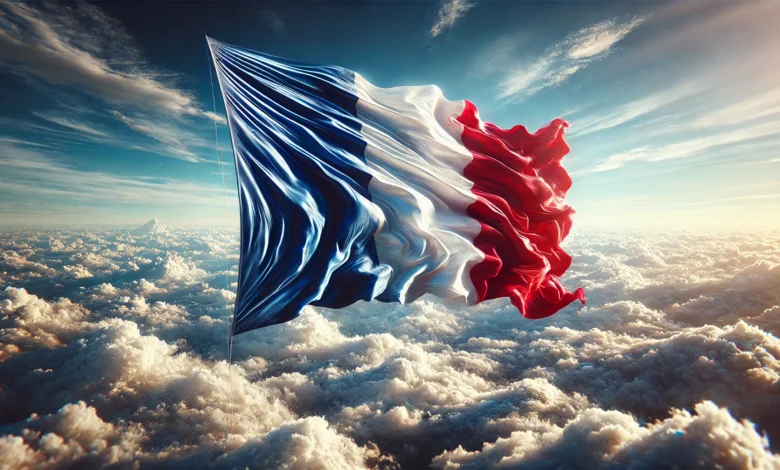The French Flag: A Symbol of Unity, Liberty, and History

The French flag, also known as the Tricolore, is one of the most recognizable national symbols in the world. Its simple yet profound design represents the values and history of France. From its revolutionary roots to its role in modern identity, the flag carries deep significance. In this article, we’ll explore the history, design, and symbolism of the French flag, along with its cultural impact and importance in both France and beyond.
The History of the French Flag
Origins of the Tricolore
The French flag as we know it today originated during the French Revolution in the late 18th century. Prior to this, France used various flags, including the fleur-de-lis, a symbol of the monarchy. However, as revolutionary fervor grew, there was a push for a new flag that would symbolize the ideals of liberty, equality, and fraternity.
The Tricolore was officially adopted in 1794, featuring three vertical stripes of blue, white, and red. These colors were inspired by the cockades worn by revolutionaries, which combined the blue and red of Paris with the white of the monarchy. Together, they symbolized the unity between the people and the crown, albeit in a new, more democratic form.
Evolution Through the Years
While the flag became a powerful symbol during the revolution, it wasn’t always consistently used. After the fall of Napoleon, the monarchy was briefly restored, and with it came the return of the fleur-de-lis. However, the Tricolore was reinstated during the July Revolution of 1830 and has remained the national flag ever since.
Over time, the flag has come to represent not just the revolutionary ideals but also the enduring values of the French Republic.
The Design and Symbolism of the French Flag
The Three Stripes and Their Meaning
The French flag consists of three vertical stripes:
- Blue: Often associated with liberty, blue represents the freedom and perseverance of the French people. It also symbolizes the city of Paris, where the revolution began.
- White: Traditionally linked to the monarchy, white now symbolizes equality and the hope for unity among all citizens.
- Red: Representing fraternity and the blood shed for freedom, red honors the sacrifices made during the revolution and subsequent struggles for justice.
Together, these colors encapsulate the principles of the French Republic: Liberty, Equality, and Fraternity.
A Simple Yet Powerful Design
The simplicity of the flag’s design is one of its strengths. Its clean lines and bold colors make it easily recognizable and visually striking. Despite its straightforward appearance, the flag carries profound meaning, serving as a constant reminder of the values France holds dear.
Influence on Other Flags
The French flag’s tricolor design has inspired numerous other national flags, particularly in countries that were influenced by French revolutionary ideals. Flags like those of Italy, Ireland, and Romania borrow elements of the Tricolore, showcasing its lasting impact on global symbolism.
The French Flag in Modern Times
A National Symbol of Pride
Today, the French flag is a symbol of national pride and unity. It is prominently displayed during national holidays such as Bastille Day on July 14th, when the country celebrates the storming of the Bastille and the birth of modern France.
The flag is also seen at international events, from diplomatic gatherings to sporting competitions like the Olympics and the FIFA World Cup. It serves as a rallying point for French citizens, both at home and abroad, fostering a sense of belonging and shared identity.
The Flag in French Politics
The Tricolore plays a significant role in French politics. It is displayed in government buildings, schools, and public institutions, symbolizing the authority and legitimacy of the French Republic. Politicians often use the flag as a backdrop during speeches, reinforcing their commitment to national values.
However, like many national symbols, the flag has also been a point of contention. Some political groups have used it to promote their own agendas, sparking debates about its meaning and representation. Despite this, the flag remains a unifying symbol for most citizens, representing the shared history and aspirations of the French people.
Global Recognition and Influence
The French flag is recognized worldwide, often associated with France’s rich cultural heritage, contributions to art and philosophy, and its historical role in promoting democratic ideals. Whether flying at embassies or displayed during international events, the flag signals France’s presence and influence on the global stage.
Cultural Significance of the French Flag
In Art and Media
The French flag has been prominently featured in art, literature, and film, often serving as a symbol of resistance, revolution, or national pride. Paintings like Delacroix’s “Liberty Leading the People” depict the Tricolore as a rallying symbol during pivotal moments in history.
In films, the flag frequently appears as a backdrop for stories of heroism, sacrifice, and patriotism, further embedding it in the cultural consciousness.
In Everyday Life
Beyond official and ceremonial uses, the French flag is a common sight in everyday life. From waving in football stadiums to being draped over balconies during celebrations, the flag brings people together in moments of joy and solidarity.
During times of national mourning or crisis, the flag is often flown at half-mast as a mark of respect, uniting the country in collective remembrance.
A Symbol of Resilience
In recent years, the French flag has been used to express resilience and solidarity in the face of adversity. Following terrorist attacks and other tragedies, citizens have displayed the flag to show unity and defiance against threats to their values. The Tricolore, in these moments, becomes a beacon of hope and strength.
Conclusion
The French flag is much more than a national symbol; it is a representation of France’s journey through history, its values, and its aspirations. From its revolutionary roots to its role in modern society, the Tricolore continues to inspire and unite. Whether fluttering in the wind on Bastille Day or held high during moments of national pride, the French flag embodies the spirit of liberty, equality, and fraternity that defines the nation.
FAQs
1. What do the colors of the French flag represent?
The blue represents liberty and Paris, the white symbolizes equality and unity, and the red stands for fraternity and the sacrifices made for freedom.
2. When was the French flag adopted?
The French flag was officially adopted in 1794 during the French Revolution and reinstated in 1830 after the July Revolution.
3. Why is the French flag called the Tricolore?
The French flag is called the Tricolore because of its three distinct vertical stripes in blue, white, and red.
4. How is the French flag used today?
The French flag is used in national celebrations, political events, and international representations of France. It is a symbol of unity and pride.
5. Which other flags were inspired by the French Tricolore?
Flags of countries like Italy, Romania, and Ireland were inspired by the tricolor design of the French flag, reflecting similar revolutionary or national values.
You may also read.
Synchrony Charitable Financial Planning




